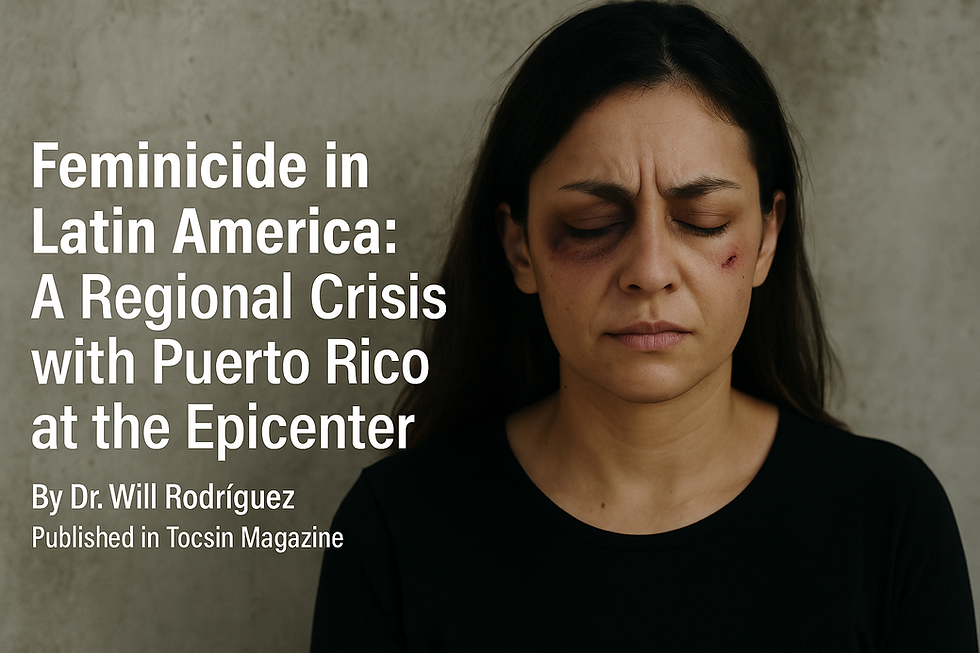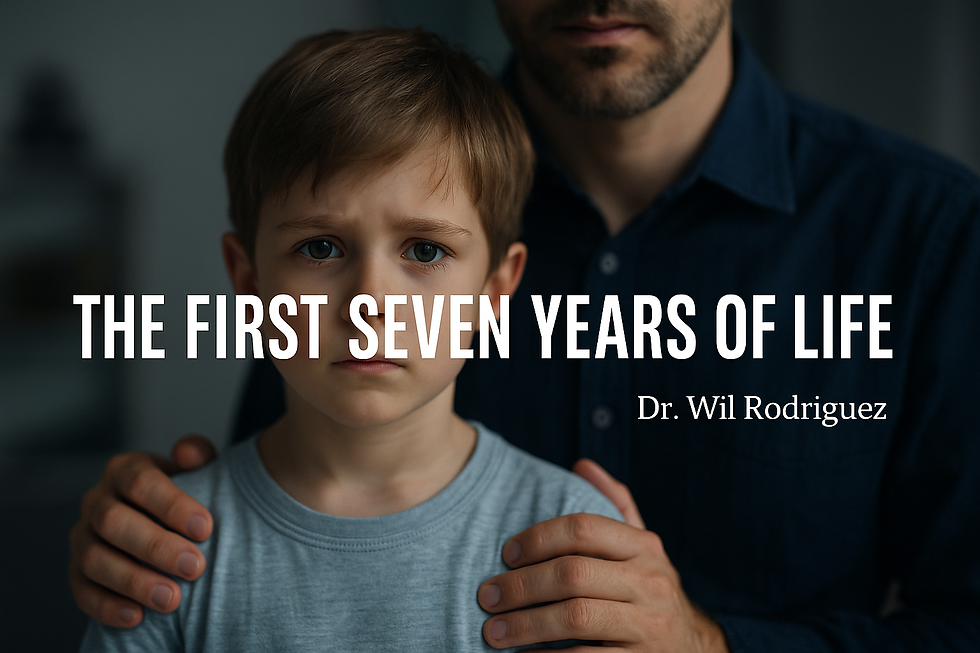Feminicide in Latin America: A Regional Crisis with Puerto Rico at the Epicenter
- Dr. Wil Rodriguez

- Jul 23
- 7 min read
By Dr. Will Rodríguez
Tocsin Magazine

Introduction
Latin America and the Caribbean face one of the world’s most devastating human rights crises: feminicide. This extreme form of gender-based violence has reached alarming proportions across the region, with Puerto Rico emerging as a particularly concerning case study that exemplifies the urgent need for comprehensive intervention strategies.
As we examine the latest data from 2024 and early 2025, the statistics paint a sobering picture of a region where being a woman often means living under the constant threat of lethal violence. This analysis explores the regional scope of feminicide while highlighting Puerto Rico’s unique challenges within this broader crisis.
The Regional Landscape: A Crisis of Staggering Proportions
The numbers speak volumes about the severity of this crisis. In 2023, at least 3,897 women fell victim to feminicide across 27 countries and territories in Latin America and the Caribbean—equivalent to 11 women murdered daily simply because of their gender. The situation has intensified in 2024, with 4,323 feminicides recorded in 17 Latin American countries, establishing a rate of 12 feminicides per day across the region.
These tragedies extend far beyond the immediate victims. During the first semester of 2024 alone, these crimes left at least 1,127 children and adolescents orphaned, with at least 570 of the victims being mothers. These figures likely represent only the tip of the iceberg, as complete family information is unavailable in 57.5% of cases.
The perpetrator profile reveals a disturbing pattern that challenges common misconceptions about stranger danger. Partners and ex-partners commit 46.7% of feminicides, while family members account for another 6%. This means that 50% of all cases occur within the family or intimate partner sphere—spaces that should represent safety and protection for women.
Perhaps most chilling is the statistic that in over 65% of reported feminicides where perpetrator information is available, the killer was a current or former intimate partner. This data confirms that homes and intimate relationships represent the most dangerous spaces for women in Latin America.
Puerto Rico: A Microcosm of Regional Crisis
Within this regional context, Puerto Rico presents a particularly alarming case that demands urgent attention. The island’s feminicide statistics reveal both the universal patterns of gender-based violence and unique characteristics that set it apart from the broader regional trend.
The Numbers Behind the Crisis
Puerto Rico’s 2024 data reveals a devastating reality: 24 feminicides occurred throughout the year, establishing a frequency of one feminicide every 4.5 days. During just the first five months of 2024, 23 women were murdered, with 10 cases classified as feminicides. Of these 10 feminicides, 8 were committed by intimate partners—representing 80% of cases and exceeding even the high regional average.
Historical analysis from 2021-2024 shows that 70% of feminicides in Puerto Rico were categorized as “intimate,” committed by partners or ex-partners. This proportion consistently surpasses the regional average of 46.7%, indicating that intimate partner violence in Puerto Rico has reached particularly dangerous levels.
The Escalating Role of Firearms
One of the most disturbing trends in Puerto Rico’s feminicide crisis is the dramatic increase in firearm usage. This escalation tells a story of increasingly lethal domestic violence that demands immediate attention from policymakers and law enforcement.
The trajectory is stark: in 2019, 47% of intimate feminicides were committed with firearms. By 2021, this figure had risen to 61%. The trend continued upward through 2022 and 2023, reaching 87% of intimate feminicides. In 2024, 75% of all feminicide cases involved firearms. Most alarmingly, by March 2025, 100% of intimate feminicides had been committed with legally obtained firearms.
This escalation from less than half to virtually all cases involving firearms in just six years represents a unique trend that requires specific intervention strategies addressing both domestic violence and firearm access.
Risk Assessment and Institutional Response
According to the Puerto Rico Institute of Statistics, one in four women on the island lives in extreme or severe danger of becoming a feminicide victim, based on the Department of Justice’s Risk Assessment Sheet. This figure represents one of the highest documented risk indicators in the region and suggests that the crisis extends far beyond the recorded deaths to encompass hundreds of thousands of women living in immediate danger.
Puerto Rico declared a state of emergency due to gender-based violence—a measure that had been demanded since 2018 by feminist organizations, activist groups, and civil society. However, continuing alarming statistics suggest the need for more effective and sustained measures beyond emergency declarations.
The establishment of Puerto Rico’s Gender Equity Observatory represents a crucial step toward evidence-based policy development, providing essential data for understanding and addressing the crisis.
Regional Context and Comparative Analysis
Puerto Rico’s situation must be understood within the broader Latin American context, where the region ranks as the second-highest globally for feminicide incidence, with 1.5 cases per 100,000 women and an annual total of 7,900 feminicides across the American continent.
Several factors distinguish Puerto Rico within this regional framework:
Relative Frequency: With one feminicide every 4.5 days in a population of approximately 3.2 million inhabitants, Puerto Rico demonstrates a concerning per capita rate that demands attention.
Firearm Escalation: The increase in firearm use from 47% to 100% over six years represents a unique trend requiring specific attention and intervention strategies.
High Population Risk: The indicator that one in four women lives in extreme risk significantly exceeds other regional territories and suggests widespread vulnerability.
Intimate Feminicides: The 70% rate of intimate feminicides surpasses the regional average of 46.7%, indicating particular challenges in addressing domestic violence.
Systemic Challenges and Barriers
The persistence and escalation of feminicide across Latin America and specifically in Puerto Rico point to systemic failures that must be addressed comprehensively.
Data and Documentation Challenges
Significant underreporting plagues the region, with 30-57% of cases lacking complete information. This data gap hampers effective policy development and resource allocation. The absence of unified investigation protocols across jurisdictions creates inconsistencies in case classification and handling.
Justice System Deficiencies
Impunity rates remain high across the region, with many feminicide cases never reaching conviction. Deficient judicial processes, inadequate specialized training for law enforcement and judicial personnel, and insufficient protective measures for victims and survivors contribute to a system that often fails to protect women.
Cultural and Social Factors
Deep-rooted machismo culture normalizes violence against women and creates social acceptance of controlling and abusive behaviors. Limited economic opportunities for women increase dependency on potentially violent partners, while social stigma around domestic violence prevents many women from seeking help.
The Path Forward: Urgent Recommendations
Addressing the feminicide crisis requires comprehensive, multi-sectoral approaches that address both immediate protection needs and long-term prevention strategies.
Immediate Interventions
Enhanced Risk Assessment Systems: Building on Puerto Rico’s existing risk evaluation framework, implementing early warning systems that can identify and protect women in imminent danger before violence escalates to lethal levels.
Firearm Regulation: Given Puerto Rico’s alarming trend in firearm use, implementing stricter background checks, mandatory waiting periods, and temporary removal procedures for domestic violence situations could save lives.
Strengthened Protection Systems: Expanding shelter capacity, improving protective order enforcement, and developing comprehensive safety planning with high-risk victims.
Long-term Prevention Strategies
Education and Awareness: Implementing comprehensive gender equality education from early ages, challenging toxic masculinity patterns, and promoting healthy relationship models.
Economic Empowerment: Creating economic opportunities for women to reduce dependency on potentially violent partners and enabling them to leave dangerous situations.
Healthcare Integration: Training healthcare providers to identify and respond to domestic violence signs, creating safe disclosure environments, and integrating violence screening into routine healthcare.
Policy and Legislative Reforms
Specialized Justice Systems: Establishing specialized feminicide courts with trained personnel, implementing victim-centered prosecution approaches, and ensuring adequate resources for investigations.
Comprehensive Data Systems: Developing unified data collection protocols across jurisdictions, improving inter-agency information sharing, and ensuring regular public reporting of feminicide statistics.
International Cooperation and Best Practices
The regional nature of this crisis calls for enhanced international cooperation and knowledge sharing. Countries showing progress in reducing feminicide rates can provide valuable lessons for others struggling with this issue.
Costa Rica’s comprehensive approach combining legal reforms, specialized courts, and prevention programs offers a model for other nations. Uruguay’s implementation of the “Tobilleras” electronic monitoring system for domestic violence perpetrators demonstrates innovative technological solutions.
Regional organizations like the Inter-American Commission of Women and UN Women play crucial roles in facilitating knowledge exchange and providing technical assistance to countries developing their response strategies.
The Role of Civil Society and Community Response
Beyond government action, civil society organizations, community leaders, and individuals all have crucial roles in addressing feminicide. Feminist organizations across Latin America have been at the forefront of demanding policy changes, providing support services, and raising awareness about gender-based violence.
Community-based prevention programs that engage men and boys in changing attitudes toward women and violence show promise in addressing root causes. Religious and cultural leaders can play important roles in challenging harmful norms and promoting gender equality.
Private sector engagement through workplace policies, economic opportunities for women, and support for prevention programs can contribute significantly to comprehensive responses.
Reflection Box
The feminicide crisis in Latin America represents more than statistics—it embodies a fundamental challenge to human dignity and equality. Each number represents a life cut short, a family destroyed, and a community traumatized.
As we examine Puerto Rico’s trajectory from 47% to 100% firearm use in intimate feminicides over six years, we witness how quickly violence can escalate when systems fail to intervene effectively. The fact that one in four women in Puerto Rico lives in extreme danger of feminicide should shock us into urgent action.
This crisis demands more than emergency declarations and policy papers. It requires a fundamental transformation in how societies value women’s lives, address gender inequality, and respond to violence. The time for incremental change has passed—the situation demands bold, comprehensive action that prioritizes women’s safety and dignity.
Every day of delay means more lives lost, more children orphaned, and more communities traumatized. The question is not whether we can afford to act decisively, but whether we can afford not to.
Join the Movement
This article is part of a broader commitment to truth, justice, and transformation.
Tocsin Magazine—named after the alarm bell rung in times of crisis—is a growing platform amplifying voices that challenge injustice and reimagine society. Dive into bold reporting, critical essays, and visionary work from across the Americas.
📖 Read more powerful articles
🗣️ Join a community of thought leaders, artists, and educators
✊ Be part of the change
Visit us at: www.tocsinmag.com







Comments